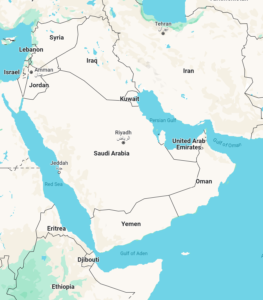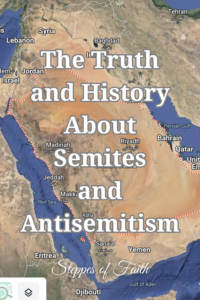
“For you are a holy people to the LORD your God.” (Deuteronomy 7:6)
Israel has battled its enemies since the day Joshua led the Israelites across the Jordan River and entered Canaan (Joshua 1:11). Since that time, antisemitic sentiments have continued to rise around the world. But are the Jewish people Semites? And what exactly is a Semite? If one is going to have an opinion about the Jewish people, it is essential to understand the history and definition.
The modern cultural definition of antisemitism tends to be “prejudice or hostility toward Jews as a religious, cultural, or racial group.” On the contrary, despite what many people believe, Semites are not a religious, cultural, or racial group at all, and it does not solely include the Jewish people. So, this definition is false.
The dictionary definition of Semite is “a member of any of various ancient and modern peoples originating in southwestern Asia, including the Akkadians, Canaanites, Phoenicians, Hebrews, and Arabs.” According to this definition, a Semite is anyone who comes or came from the Middle East or Africa and speaks Hebrew, Arabic, or Aramaic. This definition is better but also wrong.
Semites do not include people of any ethnicity—it is a term referring to a group of languages and dialects spoken by a group of people in a given geographical location. In the study of philology (languages), similar terms exist for other groups, including Indo-Germanic/European, Indo-Aryan, and Syro-Arab.
Further, “Semitic” does not refer only to the Jewish people since it also classifies Ethiopians, Turks, Persians, Arabs, and others. For this reason, it is disingenuous to assign the term Semite to only the Jewish people.
So, why is Semite so closely associated with them and not others? Some believe it stems directly from the Bible.
Father of the Semites?
The Bible describes Noah’s descendants in Genesis 10. His oldest son was Shem. In Greek and Latin, Shem becomes “Sem” since neither language includes the letter H. Therefore, some erroneously consider Shem to be the father of the Semites.
After surviving the Great Flood aboard the ark (Genesis 6), Noah and his family repopulated the earth. Shem eventually had a great-great-grandson named Joktan, who established the Joktanite tribe that dispersed throughout the Persian Gulf, northern Africa, and the Middle East.
Genesis 10 tells us where the Joktanites were mainly located.
“And their dwelling place was from Mesha as you go toward Sephar, the mountain of the east.” (Genesis 10:30)
It is somewhat challenging to know where Mesha (Mecca in Arabic) was once located. Some scholars conclude that it might have been near the mouths of the Tigris and Euphrates Rivers. More likely, it was an area encompassing a large area of modern,
- Southern Turkey
- Syria
- Iraq
- Eastern Iran
- Jordan
- Kuwait
- United Arab Emirates
- Saudi Arabia
- Oman
- Parts of Yemen
- A small portion of Ethiopia.
In his 1871 book The Geography of Arabia, the late English author Charles Forster described that Mesha may have included the Zames mountain range, now called the Nejd (or Najd) Mountains. These are the mountains Moses refers to in Genesis 10:30—” the mountain of the east.”
The ancient Mesha area still contains a variety of ancient Joktanite people. Some believe that the Nejd Mountains separate the Joktanites from Arabs descended from biblical Ishmael, Abraham’s first-born son and Isaac’s brother (Genesis 16:3). Interestingly, if true, one could suggest that the mountains separate God’s chosen people from the people descended from the “father of the Arabs,” who are overwhelmingly Muslim.
As for Sephar, it was a town within Mesha in southern Yemen, now named Al-Shihr, though it has also been known as Dhafar and Zaphar.
With such a widespread geographical history, one can see that the Jewish people are not the only Semites. Anyone from the historical Joktanite area who speaks any of the many languages spoken there is a Semite.

Origin of Semite
Toward the end of the 18th century, philologists at Germany’s Gottingen School of History coined “Semite.” Philologists now consider it an obsolete expression.
Though people derived Semite from the biblical name Shem, they disregarded the fact that different languages came into practice several generations after Shem. The greatest biblical example is in Genesis 11, when God disrupts the people’s intentions of building a tower high enough to reach heaven by confusing their ability to communicate.
“Come, let Us go down and there confuse their language that they may not understand one another’s speech. So the LORD scattered them abroad from there over the face of all the earth, and they ceased building the city. Therefore, its name is called Babel because there the LORD confused the language of all the earth.” (Genesis 11:7-9)
Because God disrupted the people’s language, the assumption that the Semite language stems from only one man (Shem) is false.
Philologists Respond
Nevertheless, most people today still consider the Jewish people (and only the Jewish people) as a religious ethnic group called Semites. A pioneer scholar in Semitic languages, Ernest Renan, once addressed the issue in 1855.
“I repeat again that the name Semite here has only a purely conventional meaning: it designates the peoples who have spoken Hebrew, Syriac, Arabic or some neighboring dialect, and in no sense the people who are listed in the tenth chapter of Genesis as the descendants of Shem, who are, or at least half of them, of Aryan [Mede, Persia, modern Iran] origin.”
Renan rightly points out that the term Semite is a language designation. Yet many continue to regard it as a race. W.W. Norton, in his book Semites & Anti-Semites: An Inquiry into Conflict and Prejudice, says race used to be an appropriate word concerning Semites but is not anymore.
“At one time, it might thus have had a connotation of race when that word itself was used to designate national and cultural entities. It has nothing whatever to do with race in the anthropological sense that is now common usage.”
Naturally, people who inhabit a large geographical area can have varying racial diversity as well as religious and cultural diversity. Such differences caused some scientists to assert a very dangerous theory, particularly toward the Jewish people.
Bad Scientists and Other Agitators
Scientists and anthropologists developed a theory in the late 19th century called “biological racism” (also known as “scientific racism” and “polygenism”). The theory attempted to classify the differences between ethnic groups based on physical and mental hereditary traits—skin color, hair, facial features, height, intelligence, etc. Examples of categories may have included “Orientals,” “Negros,” “Caucasians,” and, of course, Semites.
The scientists concluded that certain groups (mainly theirs) were superior to others. The result was that many in society, including clergymen, politicians, and artists, began using derogatory, insensitive terms that remain common today, such as redskin, coon, nigger, chink, gook, towelhead, kike, and Jew. Thus, racism was born.
One particular scientist was American anthropologist Samuel George Morton. He often promoted the wild idea that the larger someone’s brain was, the more intelligent and civilized they were. In 1839, he published a book called Crania Americana in which he compiled a list of people’s physical features and characteristics, a list many others actively used to formulate their attitudes and opinions toward other ethnic groups.
By 1879, a German protestor named Wilhelm Marr took the growing erroneous ideas regarding Semites and coined the term “antisemitism.” He used it to describe not only anti-Jewish campaigns that were occurring in central Europe at that time but also his own opinions of the Jewish people.
Not long after, in 1889 France, Edouard Drumont formed the Antisemitic League of France with the support of many other influential right-wing nationalists, including French newspapers and even the Catholic Church. The League was very active in promoting literary antisemitic propaganda (especially during the Dreyfus Affair in 1894) and holding public demonstrations.
The League collapsed ten years later in 1899, but the damage was done. Its effects continued to affect French society and many others worldwide, not the least of whom was Hitler. As a result, racist perspectives toward the Jewish people took a terrible hold and still do today.

Know What Semites Are
Though many people, including Christ-followers, refer to the Jewish people as Semites and commonly think of anyone’s opposition to them as antisemitic, both terms are patent misnomers.
A true Semite is anyone who descended from the area once occupied by the Joktanite tribe and speaks those languages. Therefore, a Semite is not only a Jewish person, especially one living in Israel, but also Arabs, Ethiopians, Iraqis, Turks, Syrians, and many others. And genuine antisemitism implies discrimination against them all.
If one is going to have an opinion about Israel and the Jewish people, then one must be informed of the truth and history of the Semites, especially followers of Christ. We should stand for the truth of who the Jewish people are (Deut 7:6) and categorically reject any historically racist assertions against them.
